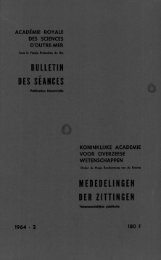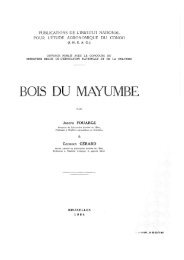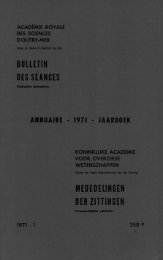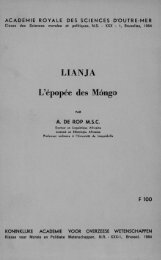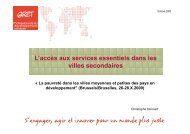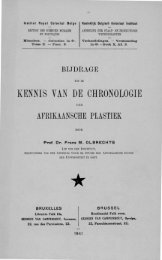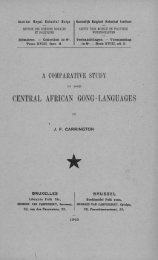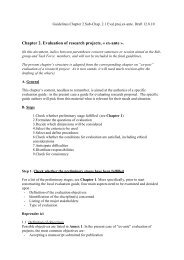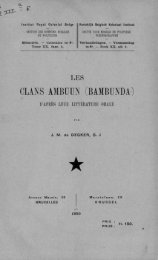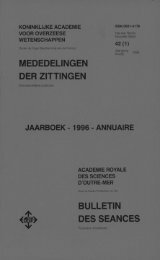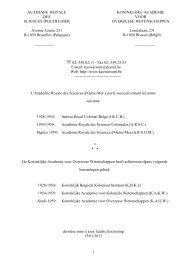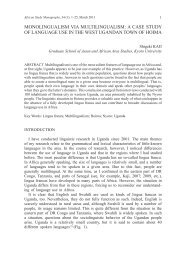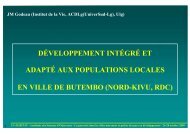bulletin des séances mededelingen der zittingen - Royal Academy ...
bulletin des séances mededelingen der zittingen - Royal Academy ...
bulletin des séances mededelingen der zittingen - Royal Academy ...
Create successful ePaper yourself
Turn your PDF publications into a flip-book with our unique Google optimized e-Paper software.
Bull. Séanc. Acad r. Sci. Outre-Mer<br />
Meded. Zitt. K. Acad, overzeese Wet.<br />
33 (1987-4): 547-560 (1988)<br />
Aerobiology and Allergy *<br />
by<br />
Peter K. C. A ustw ick**<br />
Su m m a r y. — Aerobiology has emerged as a major entity in human and veterinary respira<br />
tory medicine primarily on its infectious propagule content, but attention is now focusing on<br />
the role o f airborne allergens as a cause o f many health problems hitherto little recognised.<br />
The origin, nature and effects of the inhalation of allergenic airborne particles on susceptible<br />
people are reviewed un<strong>der</strong> the two types o f allergy involved, viz. «immediate» (Type I) and<br />
«delayed» (Type III). Consi<strong>der</strong>ation o f the airborne concentrations o f particles associated with<br />
allergy suggests that Type I allergy is precipitated by a relatively small intake into the upper<br />
respiratory tract (perhaps even a single pollen grain), whereas Type III (EAA) requires the<br />
deposition o f large numbers of very small particles deep in the lung tissue. Many different<br />
airborne biological particles are allergenic, ranging from the spores o f plants (pollen), fungi,<br />
bacteria and actinomycetes to fragments o f plant and animal tissues and the condensation<br />
nuclei o f droplets of microbial metabolites released from spray humidifiers. New developments<br />
in allergy are delineating the many allergenic components o f these complex materials, enabling<br />
the identification and assay of specific major allergens in air and hence determination o f causal<br />
levels o f exposure.<br />
R ésum é. — Aérobiologie et allergie. — L’aérobiologie s’est développée pour constituer une<br />
entité majeure dans le domaine de la médecine respiratoire humaine et vétérinaire, initialement<br />
par l’attention qu’elle portait aux germes infectieux que dissémine l’atmosphère, mais à présent<br />
l'attention s’y concentre sur le rôle <strong>des</strong> allergénes atmosphériques, en tant que cause de<br />
nombreux problèmes de santé jusqu’ici peu connus. L’origine, la nature et les effets de<br />
l’inhalation de particules atmosphériques allergisantes sur <strong>des</strong> sujets sensibles sont passés en<br />
revue pour les deux types d’allergie concernés, à savoir l’«allergie immédiate» (Type I) et<br />
l’«allergie retardée» (Type III). L’examen <strong>des</strong> concentrations dans l’atmosphère de particules<br />
responsables d’allergie suggère que l’allergie de Type I est provoquée par une absorption<br />
relativement peu importante au niveau <strong>des</strong> voies respiratoires supérieures (un seul grain de<br />
pollen peut suffire), tandis que le type III (AAE) ne survient qu’à la suite du dépôt de gran<strong>des</strong><br />
quantités de très petites particules dans la profondeur du tissu pulmonaire. De nombreuses<br />
particules d’origine biologique véhiculées par l’atmosphère sont allergisantes : elles vont <strong>des</strong><br />
spores végétales (pollen), champignons, bactéries, actinomycètes, jusqu’aux fragments de<br />
tissus végétaux et animaux et aux noyaux de condensation <strong>des</strong> gouttelettes de métabolites<br />
microbiens dispersés par les humidificateurs à aspersion. De nouveaux développements <strong>des</strong><br />
* Paper read at the 1st Conference Raymond Vanbreuseghem held on 6 November 1987.<br />
** Senior Research Fellow; Robens Institute of Industrial and Environmental Health and Safety,<br />
University of Surrey, Guilford, Surrey (United Kingdom).



